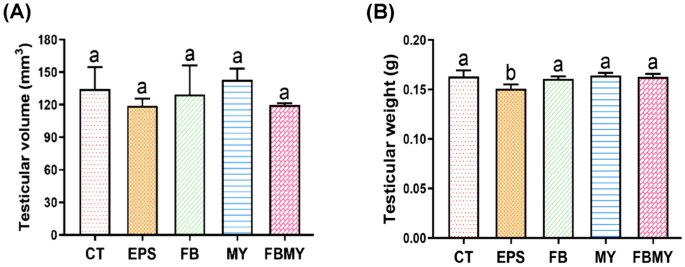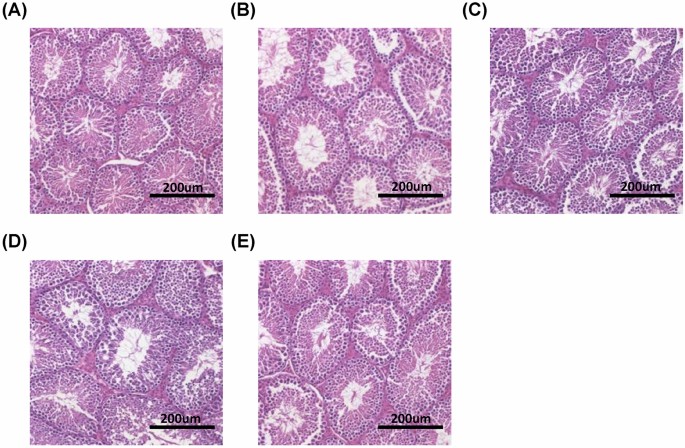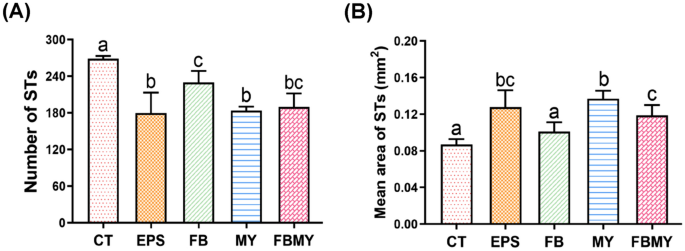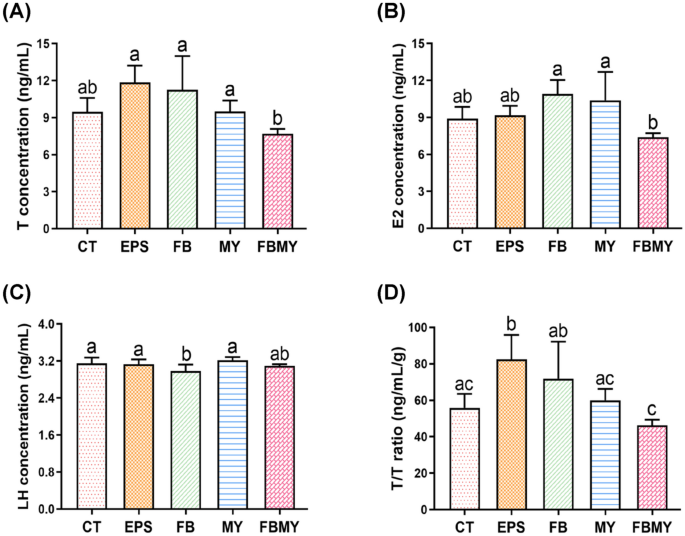Main components of the four C. militaris fermentation products
Table 1 showed that the content of polysaccharides in the EPS group was the highest, and was significantly higher than those in the FB, MY and FBMY groups (p < 0.05). There were significant differences in the contents of cordycepin and adenosine in the four C. militaris fermentation products (p < 0.05), and all had the highest content in the FB. Except between the FB and EPS, protein concentrations in different fermentation products were all significant differences (p < 0.05). The protein concentrations in the MY was the highest, followed by in the FBMY, in the FB, and in the EPS was the lowest. In this study, EPS were obtained from FB by ethanol precipitation. When the EPS in FB were precipitated with ethanol, cordycepin could not be simultaneously precipitated because of its good solubility in water and ethanol. Thus, the cordycepin content in the EPS was below detectable levels.
Effects of C. militaris fermentation products on food and water intake and body weight gain
Food and water intake and body weight gain in mice of all groups are presented in Fig. 1. The food intake of JM mice in the experimental groups fed with C. militaris fermentation products (EPS, FB, MY, and FBMY) was significantly higher than that of the CT group that were fed a normal diet (all p < 0.05; Fig. 1A). JM mice in the EPS group had the highest food intake (p < 0.001 vs. CT, p = 0.007 vs. FB, p = 0.034 vs. MY, p = 0.343 vs. FBMY). A possible explanation for this phenomenon is that the sweetness of EPS increases the palatability of the pellets. Moreover, there were no significant differences in water intake (Fig. 1B) or body weight gain for 28 days (Fig. 1C) between the experimental groups and the CT group (all p > 0.05). Although mice in the EPS group ate more than mice in the other groups, their body weight gains were only significantly increased when compared with the FB group (p < 0.05). These results imply that body weight gain in JM mice is controlled or regulated by EPS addition, thereby preventing obesity.
Effects of C. militaris fermentation products on food and water intake and body weight gain of JM mice during the 28-day experiment. Food intake (A), water intake (B), and body weight gain (C) were shown in different indicated groups. Values are presented as means ± SD (n = 5 for all test groups). Panels marked with different lowercase letters are significantly different (p < 0.05).
Recently, the regulatory role of some medicinal fungi on obesity has been gradually clarified through 16S rRNA gene sequencing and metabolomic studies17,18,19,20,21,22. Since intestinal bacteria can not only increase the absorption of intestinal monosaccharides and short-chain fatty acids and promote the fat accumulation in the liver tissue23, but the lipopolysaccharide of gram-negative bacteria can also bind to receptors on the surface of immune cells, causing an inflammatory response thereby aggravating obesity24. Previous studies have demonstrated that O. sinensis can reduce the amounts of Enterococcus cecorum and modulate a bile acid receptor, thereby attenuating lipid metabolism disorders and their associated inflammation in high-fat diet (HFD) mice25. C. militaris polysaccharides could increase gut bacteria negatively associated with obesity traits, decrease the population of gram-negative bacteria, effectively improve intestinal flora dysbiosis in HFD-induced mice, and regulate the levels of metabolites, thereby reducing body weight, fat accumulation, and pro-inflammatory cytokine levels in mice26,27. Selenium-enriched C. militaris could reduce serum triglyceride and low-density lipoprotein cholesterol levels, inhibit serum lipopolysaccharide-binding proteins, adiponectin levels, and pro-inflammatory gene expression in HFD mice, and improve the expression of related anti-inflammatory genes28. Although the mechanisms remain to be elucidated, C. militaris fermentation products, especially EPS, may effectively prevent obesity during the development of JM mice by modulating the intestinal flora.
Effects of C. militaris fermentation products on apparent testicular parameters
Testicular volumes and weights of JM mice in each group are shown in Fig. 2. There were no significant differences in testicular volume between the experimental and CT groups (all p > 0.05; Fig. 2A). Mice in the MY group had the largest testicular volumes. Furthermore, mice in all groups, except the EPS group, showed similar results (all p > 0.05; Fig. 2B). Mice in the EPS group had the lowest testicular weight and showed significant differences compared with mice in the other groups (p = 0.004 vs. CT; p = 0.013 vs. FB; p = 0.002 vs. MY; p = 0.005 vs. FBMY).
Effects of C. militaris fermentation products on apparent testicular parameters of JM mice. Testicular volumes (A) and testicular weights (B) were shown in different indicated groups. Values are presented as means ± SD (n = 5 for all test groups). Panels marked with different lowercase letters are significantly different (p < 0.05).
It has been reported that cordycepin reduces fat accumulation around the epididymis of HFD rats29 and significantly reduces epididymal adipocyte sizes in a dose-dependent manner30. In addition, C. militaris polysaccharides can decrease epididymal fat index by modulating the expression of key genes and proteins in epididymal fat31, including reducing sterol regulatory element binding protein-1c level by approximately 49%, inhibiting the expression of peroxisome proliferator-activated receptor γ protein by approximately 67%32, thereby significantly reducing epididymal adipogenesis. This suggests that the decreased testicular weight of JM mice in the EPS group may be related to the fact that EPS can reduce lipid and adipocyte differentiation in testis and surrounding tissue. Since the testes play crucial roles in producing sperms and synthesizing androgens, the testicular structure, sperm parameters, and sex hormone levels in sera were further evaluated.
Effects of C. militaris fermentation products on testicular morphology and structure
The hematoxylin and eosin (H&E) staining images of testicular sections of JM mice from each group are shown in Fig. 3. The morphology and structure of the seminiferous tubule (STs) were normal, and germ cells in the STs were in a regular arrangement in all groups. In the same field of view, STs were larger, and sperm cell densities were higher in all experimental groups than in the CT group. These results indicate that C. militaris fermentation products promote ST development in the testes of JM mice. Therefore, we evaluated the effect of C. militaris fermentation products on the morphological indicators of STs.
Effects of C. militaris fermentation products on testicular morphology and structure. Testicular sections of the CT group (A), EPS group (B), FB group (C), MY group (D), and FBMY group (E) were stained with H&E. Scale bars: 200 μm. Panels marked with different lowercase letters are significantly different (p < 0.05).
The number and mean area of the STs of JM mice in each group are presented in Fig. 4. The number of STs in all experimental groups was significantly lower than that in the CT group (p < 0.05; Fig. 4A). Mice in the EPS group had the lowest number of STs (p < 0.001 vs. CT, p < 0.001 vs. FB, p = 0.761 vs. MY, p = 0.052 vs. FBMY). Moreover, the mean area of STs in all experimental groups, except for the FB group, was significantly larger than that in the CT group (all p < 0.05; Fig. 4B). The mean area of STs was the largest in the MY group (p < 0.001 vs. CT, p = 0.221 vs. EPS, p < 0.001 vs. FB, p = 0.025 vs. FBMY). The larger the mean area of the STs, the more mature the STs.
The STs of the testis are the site of spermatogenesis and are composed of spermatogenic cells and Sertoli cells, the former producing sperm and the latter supporting and nourishing spermatogenic cells33. In this study, except that EPS significantly reduced testicular weight, C. militaris fermentation products did not significantly affect testicular volumes or weights of JM mice, but significantly increased the size and maturation of STs. These results suggest that C. militaris enhances testicular development, thereby promoting spermatogenesis in JM mice.
Effects of C. militaris fermentation products on sperm parameters
To further assess male reproductive development, sperm concentrations and ratios of motile sperm in the epididymis were analyzed (Table 2). Sperm concentrations in JM mice in all experimental groups were higher than in the CT group. Mice in both the FB and MY groups showed significant increases in sperm concentrations compared to the CT group (p < 0.05). Mice in the MY group had the highest sperm concentrations. Furthermore, the ratio of motile sperm was also higher in all experimental groups than in the CT group. Except for the MY group, the motile sperm ratios in all experimental groups were significantly higher than in the CT group (all p < 0.05). Ratios of motile sperm were the highest in the FBMY group.
Based on the results shown in Figs. 3, 4 and Table 2, C. militaris fermentation products promoted the development and maturation of STs, enhanced spermatogenesis in the testes, and increased mature sperm concentration and motile sperm ratio in the epididymis. These results are consistent with reports showing increased sperm concentrations and motilities in boars34 and Sprague–Dawley rats35 following MY supplementation.
Oxidative stress is an important cause of testicular damage, which can lead to testicular dysplasia, spermatogenic cell necrosis and apoptosis, resulting in male reproductive dysfunction36. C. militaris is a natural antioxidant with excellent ability to scavenge reactive oxygen radicals37. Among them, cordycepin can regulate the activities of downstream antioxidant enzymes through the SIRT1/Foxo3a signaling pathway38, as well as regulate NF-κB activation and MAPKs signaling39, effectively improving sexual dysfunction in aged rats. Moreover, another study showed that the EPS extracted from the C. militaris FB could promote the proliferation of spleen T and B lymphocytes through MAPK signaling40; thus, EPS may also be able to resist testicular oxidation through this pathway. Therefore, the antioxidant activities of C. militaris may explain why these fermented products can promote male reproductive development in JM mice.
Effects of C. militaris fermentation products on serum sex hormone levels
To investigate the effects of supplementation with C. militaris fermentation products on male reproductive development, the serum sex hormone levels of JM mice were analyzed (Fig. 5). Although mice in both the EPS and FB groups showed higher testosterone (T) concentrations than those in the CT group, there were no significant differences in T concentrations between each experimental group and the CT group (all p > 0.05; Fig. 5A). Mice in the EPS group had the highest T levels. However, T levels in mice in the FBMY group were significantly lower than those in the other experimental groups (all p < 0.05), but not in the CT group.
Effects of C. militaris fermentation products on serum sex hormone levels in different indicated groups. T concentration (A), E2 concentration (B), LH concentration (C), and calculated T/T ratio (D) were shown. Values are presented as means ± SD (n = 5 for all test groups). Panels marked with different lowercase letters are significantly different (p < 0.05).
Since estradiol (E2) levels may antagonize the effects of T, serum E2 levels were also analyzed. Although mice in both the FB and MY groups showed higher E2 concentrations in sera than those in the CT group, there were no significant differences in E2 concentrations between each experimental group and the CT group (all p > 0.05; Fig. 5B). However, E2 levels were the lowest in the FBMY group but only significantly different when compared to the FB and MY groups (both p < 0.05). In males, E2 is mostly converted through the aromatization of T41. The results shown in Figs. 5A,B support the positive correlations between T and E2 levels, and the lower E2 concentration, resulting in lower testicular volumes, number of STs, and sperm concentrations in epididymis of mice in the FBMY group. However, the reason for the lower T and E2 levels in the FBMY group than in the other groups remains to be elucidated.
Since luteinizing hormone (LH) is secreted by the anterior pituitary gland, which stimulates ovulation in females and androgen synthesis in males, serum LH levels were analyzed. Except for the FB group, there were no significant differences in LH concentrations among the other groups (all p > 0.05; Fig. 5C). However, the LH levels were significantly lower in the FB group than in the CT, EPS, and MY groups (all p < 0.05). The synthesis and secretion of sex hormones are regulated mainly by the hypothalamus-pituitary-gonadal axis. Thus, increases in both T and E2 levels in the FB group may have a negative effect on the LH levels secreted by the pituitary gland. This explains why mice in the FB group had the lowest LH levels.
Since T concentrations in testes are at least 25–100 times higher than those in sera42, the ratios of serum T levels to testicular weights (T/T) were calculated to directly assess the ability of testes to synthesize T. Results showed that T/T ratios were higher in all experimental groups, except the FBMY group, than those in the CT group (Fig. 5D). The T/T ratios were the highest in the EPS group and showed significant differences when compared with the CT, MY, and FBMY groups (all p < 0.05). Moreover, the T/T ratios of the FBMY group were the lowest and showed a significant decreases when compared with those of the EPS and FB groups ( p < 0.05), but there was no significant difference with the CT group.
The results shown in Fig. 5 indicated that C. militaris fermentation products, especially EPS, promote the development of testes and elevate serum levels of T and T/T ratios in JM mice. Our findings agree with one previous study that demonstrated a C. militaris-induced increase in T productions in Sprague-Dawley rats 43. Another study showed that O. sinensis stimulates T productions in vivo and in vitro 44. Polysaccharides and glycoproteins of O. sinensis share structural similarities with LH and can be recognized by LH receptors on Leydig cells to stimulate T productions. Although the specific mechanism remains unknown, C. militaris fermentation products, especially EPS, showed androgen-like activity, which can promote male reproductive development in JM mice.
The results shown in Figs. 2, 3, 4 and 5 and Table 2 indicate that C. militaris fermentation products, especially EPS, promote the development of testes, elevate serum levels of T and T/T ratios, and then increase sperm concentrations and ratios of motile sperms in the epididymis of JM mice. Since all mice in this study were fed ad libitum, it is possible that the EPS-containing feed increased the mice’s appetite due to its sweetness. From our results, increased EPS intake may better promote reproductive development in male JM mice. In addition, C. militaris extract has been reported to prevent obesity and fat accumulation in ovariectomized rats, lower triglyceride levels, and enhance estrogen receptor agonistic activity and phosphorylation, effectively regulating menopause-induced obesity45. Therefore, these findings suggest that C. militaris fermentation products can promote the reproductive system health and prevent metabolic syndromes including obesity.





